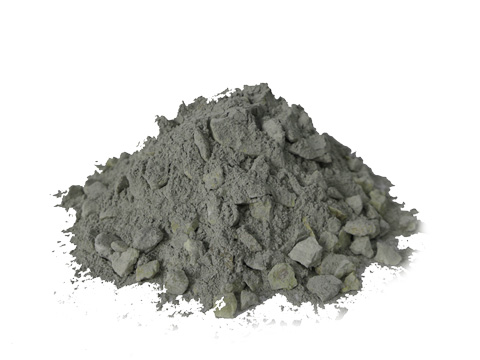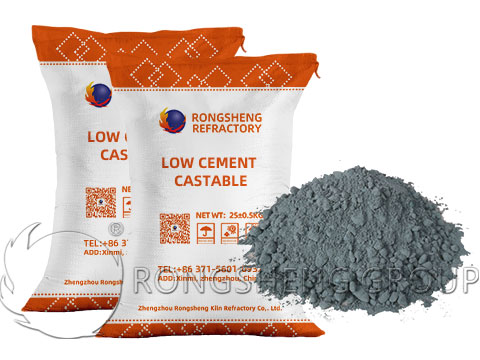Regarding the question “what is the specific gravity of castable refractory?”, refractory material manufacturers indicated that what many people want to ask is actually the weight (tons) of a cubic castable refractory. Enterprises generally purchase castable refractory according to the actual working conditions of their industrial kilns. Rongsheng refractory castable manufacturer published a popular science blog on the conversion of castable refractory specific gravity. Generally speaking, refractory castables have bulk density, including mizzou castable refractory. For example, 2.0, 2.6, and so on. The higher the bulk density, the heavier the castable refractory will be. For example, a cubic 2.0 body density castable is about two tons, and a 3.0 body density is about three tons.

What factors determine the weight of the castable refractory?
- The density of the aggregate. The greater the density, the heavier the weight of the castable refractory unit cube.
- The level of aluminum content. Generally, the higher the aluminum content, the heavier the castable refractory.
The density of aggregate depends on its chemical composition and porosity. For example, the higher the alumina content in the aluminum-silicon-based lightweight aggregate, the greater the density, the greater the porosity, and the smaller the bulk density.
Is it true that the higher the density of the castable refractory, the better?
It is ridiculous to say that the denser the refractory castable, the better. In fact, the density of the castable refractory is determined according to the performance, the parts used and so on. For example, some places need to use high-density castables, but some places need small-density castables. Therefore, it is not that the higher the density of the castable, the better. It is necessary to choose a suitable castable refractory according to the specific construction site.
insulating castable for boiler
Insulating castable is mainly made of light insulation aggregate. It is a kind of hydraulic material that is prepared by dry mixing according to the optimal ratio with bonding material. It has the characteristics of small bulk density, low thermal conductivity, high strength, and small shrinkage. It can be poured directly after on-site mixing (video of insulating castable on-site construction). Insulating castable is widely used in boilers, industrial furnaces, and other body insulation engineering fields. Insulating castable for general boilers chooses lightweight castables with a bulk density of 0.8 or 1.0.
Bulk density and thermal conductivity of castable refractory
As a refractory manufacturer, it is certain that the greater the bulk density of the castable refractory, the greater the thermal conductivity. In general, different bulk densities of castable refractory have different thermal conductivity.
- The thermal conductivity of the castable with a specific gravity of 1 is about 0.26 W/(m.k);
- The thermal conductivity of the castable with a specific gravity of 1.4 is about 0.8 W/(m.k);
- The thermal conductivity of the castable with a specific gravity of 2.2 is about 1.45 W/(m.k);
If the metal wire is added to the castable, the thermal conductivity value will be larger.
- The density of 0.8 is 0.28 W/(m.k),
- The density of 1.2 is 0.4W/(m.k),
- The density of 1.6 is 0.6W/(m.k).
That is to say, the smaller the bulk density of the insulating castable, the smaller the thermal conductivity, and the better the insulation function. Boiler thermal insulation linings refer to the operating temperature and thermal conductivity to select thermal insulation castables with appropriate bulk density. Generally, companies that purchase insulating castables will customize insulating castables according to their needs. The insulating castable of different materials is used for the insulation layer of boilers and low-temperature kilns at different temperatures. In order to save the production cost to the greatest extent.
The difference between dense castable and insulating castable of the same material
The biggest difference between dense castable and insulating castable is the bulk density. The body density of the dense castable is above 2.0, while the body density of the insulating castable is below 1.5.
The castable refractory of the same material, the dense castable, and the insulating castable have very different uses. The insulating castable is used for heat insulation in the heat insulation area. Dense castable is used in the working layer, mainly for fire resistance and wear resistance.
Insulating castable has low thermal conductivity, good thermal insulation performance, and a relatively low price. It is used in the heat treatment lining of thermal kilns for both heat insulation and heat preservation. Therefore, lightweight castables are also called lightweight heat-insulating castables or lightweight heat-insulating castables. Lightweight castables can only be used for thermal insulation and cannot be used in the working layer.
dense castable has high body density, wear resistance, high-temperature resistance, and corrosion resistance. Therefore, it is also called wear-resistant refractory castable, which can be used in direct contact with the flame in the kiln, so the heavy castable plays the role of high-temperature resistance and wear resistance.
During construction, heavy castables have less water, good strength, and long service life, while light castables are twice as much water as heavy castables because light castables are non-absorbent materials. When pouring, the template should be painted with waterproof paint to prevent the loss of castables. If water is lost, the fluidity of the castable will decrease, and it will be difficult to discharge air bubbles, which will affect the strength. However, if the amount of water added to the quality castable is too large, it will affect the discharge of crystal water and free water. It affects the strength of later use, which is also a major difference between heavy castables and light castables.

low cement castable LC-70
low cement castable LC-70 is an ultra-low cement bonded high-strength no-bake low cement refractory castable with a service temperature of 1350°C. It is mainly used in heating furnaces, rolling steel heating furnaces, annular heating furnaces, well-type heating furnaces, pushing steel heating furnaces, etc. The product grade of low cement castable is named after the initial letter of the ingredient content. The letters are the abbreviations “L” and “C” for “alumina” and “calcium oxide” respectively, and the representative value of the content is 70% AL2O3.

